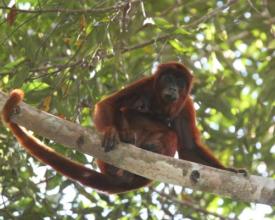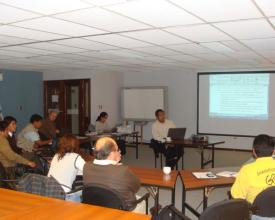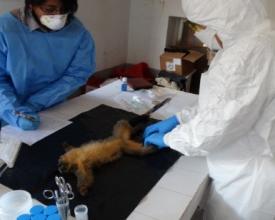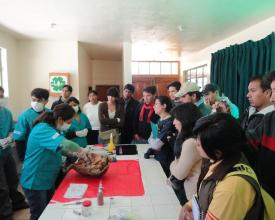
Vigilancia de virus zoonóticos en animales salvajes para prevenir brotes de enfermedades en Bolivia
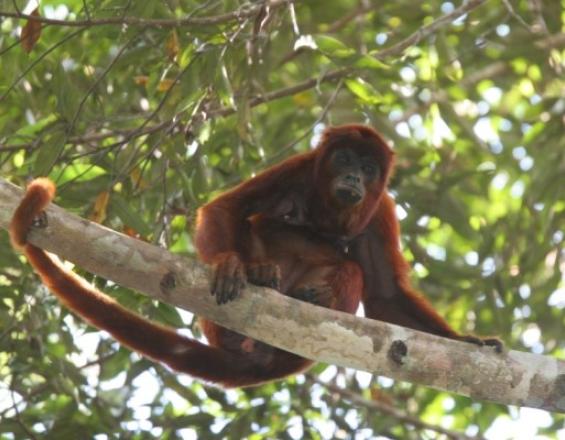
De 2010 a 2013, el proyecto PREDICT del Programa de Amenazas Pandémicas Emergentes de USAID en Bolivia mejoró las capacidades de vigilancia de las enfermedades de la fauna silvestre dentro de un enfoque de Una Salud. Se promovió la colaboración con los organismos gubernamentales para las investigaciones de campo, la detección de riesgos y la respuesta rápida; se formó a las principales partes interesadas en la vigilancia de las enfermedades de la fauna silvestre; y se mejoraron las capacidades de diagnóstico en los laboratorios locales. Como resultado, en 2012 el personal capacitado informó de un evento de mortalidad que afectaba a los monos aulladores rojos(Alouatta sara). La investigación del brote confirmó la presencia del virus de la fiebre amarilla, un flavivirus transmitido por mosquitos que afecta de forma agresiva a primates neotropicales no humanos y puede causar una enfermedad aguda y a menudo mortal en humanos. La eficaz comunicación entre el equipo de PREDICT y las autoridades sanitarias nacionales permitió una alerta inmediata y la rápida aplicación de medidas para prevenir los casos humanos, entre ellas la vacunación de la población humana de riesgo, la educación y divulgación públicas y el control de los mosquitos.
Contexto
Défis à relever
En Bolivia, como en muchos países en desarrollo, los sistemas de salud son más reactivos que preventivos, por lo que las medidas de control suelen aplicarse una vez detectado un brote. A pesar de su importancia para predecir potenciales eventos sanitarios de alto riesgo para las poblaciones humanas, rara vez se implementan sistemas de vigilancia para monitorear enfermedades en la fauna silvestre. La falta de concienciación, formación y conocimientos, así como la insuficiencia de recursos diagnósticos y financieros para vigilar los eventos sanitarios en la fauna salvaje limitan la posibilidad de recoger muestras adecuadas y analizarlas para detectar enfermedades de la fauna salvaje, incluidas las zoonosis. Además, los canales de colaboración entre sectores rara vez son óptimos, lo que reduce la capacidad general de respuesta ante brotes zoonóticos de origen en la fauna salvaje.
Ubicación
Procesar
Resumen del proceso
Se formó a las personas que trabajan y/o viven cerca de animales salvajes en regiones de alto riesgo de aparición de enfermedades, para promover la vigilancia de las enfermedades de los animales salvajes. Paralelamente, se prestó apoyo para aumentar las capacidades de los laboratorios locales, mejorando la rápida detección e identificación de patógenos con potencial zoonótico en la fauna salvaje. Los canales de comunicación y la confianza entre los colaboradores fueron cruciales para facilitar el rápido flujo de información, de modo que pudieran activarse investigaciones rápidas durante posibles epizootias. Los acuerdos de colaboración y las buenas relaciones establecidas durante las formaciones y reuniones intersectoriales permitieron que, en base a la concienciación y comprensión generadas sobre la importancia de la investigación de enfermedades, los costes fueran compartidos por los socios implicados durante las diferentes fases de la investigación evitando retrasos para la obtención y transporte de especímenes debido a limitaciones económicas y de personal de un sector en particular. Una vez obtenidos, el personal de PREDICT comunicó los resultados de laboratorio a las autoridades sanitarias y apoyó el análisis de riesgos de la situación para que se adoptaran estrategias rápidas para contener el brote de YFV y prevenir la aparición de casos humanos.
Bloques de construcción
Facilitar la cooperación intersectorial
Este elemento básico consistía en facilitar el diálogo entre agentes hasta entonces aislados: organismos gubernamentales, investigación, población local, etc. Cuando las diferencias entre sectores se abordan antes de aplicar las soluciones, pueden tenerse en cuenta diversas voces y opiniones, y las soluciones desarrolladas suelen aplicarse y aceptarse más fácilmente.
Factores facilitadores
Todos los agentes deben estar abiertos a la colaboración, la retroalimentación y las aportaciones de sectores que quizá no hayan considerado relevantes en proyectos anteriores.
Lección aprendida
Contar con una organización líder (la Wildlife Conservation Society en Bolivia) con una larga trayectoria de trabajo en el país, con una experiencia bien fundamentada y buenas relaciones institucionales establecidas, fue crucial para facilitar la rápida implementación y el buen desarrollo de las actividades del proyecto PREDICT. Durante el tiempo que PREDICT estuvo trabajando en Bolivia (de 2010 a 2013), se hicieron esfuerzos para facilitar el establecimiento de un Plan Nacional de Vigilancia de Zoonosis donde el Ministerio de Salud, el Servicio Veterinario Nacional y la Dirección General de Biodiversidad pudieran asegurar una colaboración permanente y sostenible entre sectores para prevenir enfermedades zoonóticas en el país. Desgraciadamente, este objetivo no pudo alcanzarse durante el periodo del proyecto, pero se sentaron las bases de dicho marco de colaboración y, como resultado, en los años siguientes se llevaron a cabo numerosas colaboraciones interinstitucionales y multidisciplinares para investigar más casos de fiebre amarilla de primates no humanos y enfermedades transmitidas por roedores.
Formación sobre herramientas de vigilancia de enfermedades de la fauna salvaje
Las principales partes interesadas (personal gubernamental de los servicios de salud pública, veterinaria y biodiversidad, personal de los centros de rescate de animales salvajes, veterinarios de campo, biólogos, técnicos de laboratorio y habitantes de comunidades indígenas) recibieron formación para estudiar el riesgo de propagación de enfermedades zoonóticas utilizando los protocolos de vigilancia PREDICT de USAID. La formación abarcó diversos temas, como la bioseguridad y el uso de EPP, la captura de animales, los métodos de muestreo para diversas especies de animales, la recopilación de datos, el empaquetado y envío de muestras, la preparación para emergencias, los sistemas de alerta temprana y las operaciones de laboratorio seguras. En toda la formación sobre herramientas de vigilancia se hizo hincapié en unos canales de comunicación claros. Se informó a todas las partes interesadas de los organismos y personas con los que debían ponerse en contacto en relación con el riesgo de enfermedades de los animales salvajes, de modo que se pudiera notificar a las partes apropiadas de manera oportuna y eficaz.
Factores facilitadores
En Bolivia, el inglés es poco hablado por los servidores públicos y los miembros de la comunidad, por lo que contar con formadores locales que impartieran la formación en español fue fundamental para facilitar el proceso de aprendizaje. La aplicación del enfoque "Una sola salud" a la formación amplió el sistema de vigilancia para incluir a partes interesadas que no habían formado parte del proceso anteriormente. Este enfoque más integrador desde el primer momento de la formación dio lugar a un sistema eficaz de vigilancia de enfermedades.
Lección aprendida
En países donde las posibilidades de formación y actualización son limitadas, sobre todo en temas novedosos como la sanidad y la vigilancia de la fauna salvaje, ofrecer posibilidades de formación a las distintas partes interesadas fue una buena estrategia para generar capacidades humanas locales y concienciación, al tiempo que se conseguía que personas de distintos sectores y zonas geográficas colaboraran en la vigilancia de las enfermedades de la fauna salvaje. Tras estas formaciones, se capacitó a las partes interesadas para que supieran qué hacer cuando la fauna salvaje sufre una enfermedad, quién debe tomar muestras, qué métodos de seguridad aplicar y cuáles son los canales de comunicación adecuados. Gracias a la formación multidisciplinar, intersectorial e interinstitucional, se facilitó el diálogo, la buena comunicación y la colaboración a largo plazo entre los diversos socios del proyecto procedentes de distintos sectores, mientras que la inclusión del sector de la sanidad pública permitió dar una respuesta rápida y eficaz para evitar un brote de la epizootia de fiebre amarilla detectada en los monos aulladores.
Mejorar la capacidad de diagnóstico de los laboratorios locales
Con el fin de facilitar la detección de patógenos potenciales en las muestras recolectadas durante las actividades de vigilancia de PREDICT, se implementaron ensayos de PCR de consenso a nivel de familia viral de bajo costo en el laboratorio socio local de PREDICT (IBMB) para la detección de 12 familias virales diferentes de importancia para la salud pública en fauna silvestre. Además, para aumentar la capacidad de diagnóstico de los laboratorios de referencia del Ministerio de Sanidad, CENETROP e INLASA, ambos laboratorios recibieron los protocolos de PCR de PREDICT para detectar familias prioritarias de virus de potencial zoonótico (coronavirus, hantavirus, flavivirus, arenavirus, alfavirus, paramixovirus, bunyavirus, filovirus, henipavirus, orthomyxovirus, poxvirus y rabdovirus). Además, se donaron a esos laboratorios cebadores y controles universales sintéticos para la detección y el descubrimiento de virus conocidos y nuevos en la fauna salvaje.
Factores facilitadores
La existencia de laboratorios con capacidad técnica y física para realizar pruebas PCR en muestras de fauna salvaje en condiciones seguras es crucial. Los técnicos de laboratorio deben estar interesados y dispuestos a aplicar nuevos protocolos y realizar investigaciones en colaboración con el personal de campo para que los resultados puedan interpretarse correctamente.
Lección aprendida
La detección e identificación rápidas de patógenos es fundamental para prevenir enfermedades en la interfase fauna salvaje-humano. Así pues, la creación de capacidades locales de laboratorio y la identificación de estrategias para su sostenibilidad en los países en desarrollo han de ser prioritarias en cualquier estrategia destinada a mejorar la salud humana y animal (incluida la fauna salvaje).
Vigilancia de las enfermedades de los animales salvajes en interfaces clave
La vigilancia sanitaria de la fauna salvaje en murciélagos, roedores y primates no humanos se llevó a cabo en interfaces clave en las que la fauna salvaje tenía más probabilidades de interactuar (directa o indirectamente) con el ganado o los seres humanos. En Bolivia, las interfaces clave entre la fauna salvaje y los animales domésticos y las personas incluían la caza de subsistencia por parte de comunidades indígenas, los entornos de fauna salvaje cautiva (centros de rescate y santuarios), los entornos peri-domésticos (dentro y alrededor de viviendas o campos humanos), el comercio de fauna salvaje, las industrias extractivas y las zonas de producción ganadera. Además, la vigilancia de enfermedades de la fauna salvaje se llevó a cabo en áreas protegidas remotas con fines comparativos, así como durante brotes de enfermedades zoonóticas en personas. Al centrarnos en animales salvajes sanos en libertad y en animales salvajes estresados o enfermos, pretendíamos aumentar las posibilidades de detectar virus conocidos y nuevos que pudieran repercutir en la salud humana y afectar a la conservación de la fauna salvaje.
Factores facilitadores
Para cubrir las distintas interfases fauna salvaje-humano identificadas, fue fundamental la colaboración de las partes interesadas formadas en la vigilancia de las enfermedades de la fauna salvaje. En algunos territorios indígenas, santuarios y centros de rescate de fauna silvestre, los capacitados recolectaron muestras de fauna silvestre y datos de vigilancia como parte de sus actividades rutinarias. Fue el personal capacitado de un santuario de vida silvestre el que detectó y notificó inmediatamente un evento de mortalidad de monos aulladores, lo que resultó en una respuesta rápida y eficiente cuando se produjo el evento de mortalidad, evitando un desbordamiento a la población humana.
Lección aprendida
Dar prioridad a las interfaces clave en las que podría producirse la propagación a la hora de llevar a cabo la vigilancia de la enfermedad genera el mayor rendimiento por la reducción del riesgo. Si bien la vigilancia no puede llevarse a cabo en todos los rincones de un ecosistema forestal, las zonas en las que los seres humanos podrían interactuar con la fauna silvestre presentan intrínsecamente el mayor riesgo. Al dirigir los esfuerzos de vigilancia, los gestores de riesgos pueden captar la información más pertinente y crear los sistemas de alerta temprana más eficaces. Con unos sistemas de vigilancia adecuados, se identificó rápidamente el caso de mortalidad del mono aullador y se puso en marcha el sistema de notificación apropiado.
Impactos
Las estrategias de trabajo adoptadas por el proyecto PREDICT del Programa de Amenazas Pandémicas Emergentes de USAID en Bolivia se basaron en generar capacidades locales en métodos de vigilancia de la fauna salvaje para un amplio abanico de participantes, facilitar la cooperación intersectorial y aumentar las capacidades locales de los laboratorios de diagnóstico. Como resultado, la detección de la primera epizootia de fiebre amarilla en primates no humanos de Bolivia se identificó por su pronta investigación (sólo transcurrieron ocho días desde la notificación del brote hasta la confirmación del virus en laboratorio). Los eficaces canales de comunicación intersectorial establecidos permitieron una notificación temprana y la puesta en marcha de una respuesta eficaz por parte del personal sanitario local consistente en campañas de vacunación, educación en salud pública y control de mosquitos en las zonas circundantes, con lo que no se registró ningún caso humano. Los esfuerzos coordinados para identificar y responder al virus de la fiebre amarilla detectado demostraron la importancia de la vigilancia de virus zoonóticos en animales salvajes como valiosa herramienta de detección precoz para prevenir brotes de enfermedades, sobre todo en paisajes sometidos a alteraciones sustanciales, como la deforestación, donde la ruptura de las barreras naturales lleva a un mayor contacto entre la fauna salvaje y las personas.
Beneficiarios
Personas que viven en zonas con cambios acelerados en el uso de la tierra, incluidas las comunidades indígenas.
Servidores de salud humana y animal.
Técnicos de laboratorios de diagnóstico locales.
Una amplia gama de partes interesadas formadas en métodos de vigilancia sanitaria de la fauna salvaje.
Fauna salvaje.
